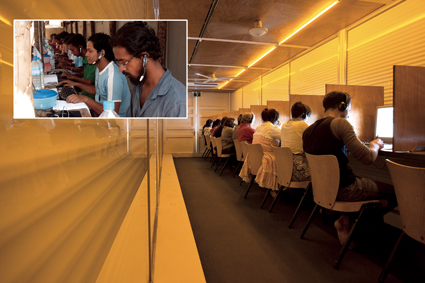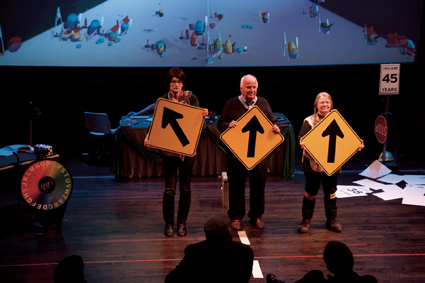it’s relational: shopping for experience
jana perkovic: recent performance in london

Life Streaming
photo Maarten van Haaff
Life Streaming
WHATEVER TERM YOU PREFER (AND I PREFER ‘RELATIONAL’, AS THIS IS PRIMARILY A THEATRE OF SOCIAL AND SPATIAL RELATIONS), THIS FORM DOMINATED THE LONDON SUMMER OF 2010. BATTERSEA ARTS CENTRE (BAC) PRESENTED AN ENTIRE FESTIVAL OF ONE-ON-ONE WORKS, WITH OVER THIRTY ONE-MAN-(OR WOMAN)-SHOWS CRAMMED INTO THE OLD BATTERSEA TOWN HALL IN SOUTH LONDON. THE MORE CENTRALLY LOCATED LIFT (LONDON INTERNATIONAL FESTIVAL OF THEATRE) DEDICATED THE LION’S SHARE OF ITS PROGRAM TO EVENTS THAT COULD JUST AS EASILY HAVE BEEN TERMED MASS GAMING, COLLECTIVE SKYPING OR SCAVENGER HUNTS.
At the Barbican, during the same period, You Me Bum Bum Train entered history as their fastest-selling show ever: part theatre, part Thank God You’re Here, it turned each audience member into the protagonist, made to improvise their way through a series of dramatic situations in front of the supporting cast of 200. With so much emphasis on you, the spectator, forgive me if the rest of this article privileges the second-person singular.
one-on-one festival
An immersive event in its own right, One-On-One Festival was possibly its own greatest achievement. The least one could sign up for was a marvellously organised afternoon of mingling through a building crammed with secret one-man wonders, appointment card in hand. The atmosphere was surprisingly welcoming, even festive: performers and spectators crossing paths in the same courtyard and café, recommendations exchanged, friendships commenced, queues spontaneously forming outside the rooms with hidden gems on the strength of on-the-spot word of mouth. Repeatedly diving into a 2-or-3-minute intensely collaborative performance, being in turns swung and shaken, kissed and sung to, frightened or intellectually challenged, by the end of the day one had no personal boundaries left to speak of.
Despite being cumulatively great, One-On-One also demonstrated how quickly an emergent genre can settle on a limited range of solutions. One kind seemed tailored to break through fears of intimacy: Abigail Conway’s On Dancefloors invites you to dance; Emma Benson sings a song with you in Me You Now. Most radically, Adrian Howells gives you a bath in The Pleasure of Being: Washing, Feeding, Holding, while Ansuman Biswas’s more open-ended 2 FREE offers the possibility of engaging with a naked, blindfolded man. However trivial they may sound conceptually, these were some of the most powerful performances in the festival, spoken about in hushed, almost spiritual tones. You found yourself entering these rooms with the same mixture of compulsion and terror with which you might climb into a roller-coaster (and they certainly act as a kind of psycho-social one, including the lag with which you process the experience afterwards). But if theatre is ever genuinely life-changing, it is in the strangely liberating afterglow that follows consensual nudity.
Another, quieter type of performance centred on material reality, and the tactile dimension of the experience generated, not so much inter-personal intimacy as greater understanding of how the world works. Barnaby Stone’s A Little Bit of a Beautiful Thing is a story of a wooden beam, a finely polished slice of which you will receive at the end. In Ray Lee’s Electric, your body becomes a conductor. Another focused on creating a first-person narrative, employing cascades of clever sensory illusions: for the 10 minutes of Just For a Moment, by Three Blind Mice, you have a drink at a pub, lie on the beach, dance Macarena in the world’s most terrible discotheque, witness a fight and have to be walked out of the pub at the end of the night, despite being blindfolded in a single room. Stan’s Café use mirrors, projection, costumes and clever framing to generate a 240-second film noir before your very eyes, with you as the chief villain, in It’s Your Film. While these works were longer, more carefully shaped and satisfied some of that need for dramatic spectacle that drives people into theatres on perfectly lovely summer days, their beauty again seemed to derive chiefly from the promise of intimacy, of being made-to-measure and the soporific pleasures of being touched, rather than from well-executed tricks.
The most accomplished works brought together the cerebral and the felt, offering an encounter while questioning its limitations. Sarah Johns’ Below plays with your perceptions: dragged into a dark room, her performance catches you before you can make sense of where you are. Facing a mirror and a singing girl, your focus shifts abruptly from one detail to another, resulting in a series of mesmerising, well-defined impressions, as if in a film. And of course, towering above the rest, is Ontroerend Goed’s trilogy of brief, but flawless works that boldly question the gullibility of the audience.
As Peggy Phelan writes, theatre has always been a meeting place, always offering the promise of a communion, an exchange—even across the proscenium arch. The relationship between audience and performer is, in her words, “the always already unequal encounter [that] nonetheless summons the hope of reciprocity and equality” (Unmarked: The Politics of Performance, Routledge, 1993). Relational performance is the inevitable end-product of this quest. Yet in it, intimacy emerges not only as a tool and a goal, but as a major concern: can we have it, how, by what means and why do we desire it in the first place? A number of works at BAC traded on the false promise of quick intimacy, and most fell short: after all, the obvious difficulties of building a rapport with the actor in five tightly scripted minutes cannot be overcome just by holding hands. Ontroerend Goed’s Smile Off Your Face, Internal and A Game of You capitalise on this disingenuousness. Internal, in particular, set up as a speed-dating session followed by a sweetly cruel group debrief, builds the illusion of a budding attraction only to break your heart (comparing notes with other viewers is soul-crushing). Yet, for all its oversharing, Internal provides a dose of needed realism in a universe made of caresses. It stands as a reminder that there is no such thing as conveyor-belt romance, no intimacy on a mass scale, and that audiences often give their hearts away too easily.

Best Before, Rimini Protokoll
courtesy the artists
Best Before, Rimini Protokoll
lift 2010
The polar opposite of the high-concept One-On-One, LIFT 2010 was a festival with an identity crisis. Rubbing shoulders were weekend events for kids, formalist community theatre and the occasional think piece. Yet here, too, the most interesting works were from the relational family.
Rimini Protokoll’s Best Before (RT96, p2) is a computer game for the whole audience. Represented by a globular multi-coloured blip, for two hours you live as a proud citizen of Bestland, making personal choices (tertiary education? children? buy a house? own a gun? try heroin?) and participating in collective decision-making (legalise drugs or guns? form an army? welcome immigrants? equal capabilities or a diverse population?). As the game progresses, you reap the fruits of some decisions and suffer the limitations of others, while your range of choices progressively narrows as you age. It is a game of consequences, but also of chance—some blips are randomly wiped out by epidemics and war while, ultimately, the whole population dies of old age. I found the end unexpectedly poignant, realising that there was no final payoff for all my prudent life choices (I had grown old with a big family and plenty of real estate). I suspect the experience varies according to your age and life experience, but also audience demographics.
Bookmarking the game is Rimini Protokoll’s trademark presence of non-performers, or rather ‘reality experts’—in this case, the game designer, a game tester, a lobbyist and a traffic flagger whom the other three would have passed by on their way to work. Their guidance and stories serve both to contextualise gaming in the real world, to relate Bestland to the political choices that Vancouver has faced, and to reconnect our personal choices to non-virtual consequences. The tension between the two aspects of Best Before, which never quite connect, is a productive one, even though I found the four Canadians’ lives infinitely more intriguing than my avatar’s cyber-shenanigans.
The real treat of the festival was Dries Verhoeven’s Life Streaming. The concept is minimal: in a makeshift internet café, each audience member conducts their own video chat with a young person in Sri Lanka. In the interstices of the poetic, but tightly orchestrated structure, filled with pre-prepared text and film and guiding us through such topics as the tsunami, loss and grief, my interlocutor and I manage to insert a real conversation about life, healthcare, the scent of the sea and lying in bed with total strangers. The work keeps the question of its own intent open, incorporating sensorial stimuli to create an exuberant experience not unlike a perfect holiday in South-East Asia, while at the same time allowing for an unusual degree of self-propelling interaction. Consequently, you come away with a real connection to a human being—if you so wish. Like Ontroerend Goed’s trilogy, Life Streaming raises big questions about art, reality and intimacy, but lets you choose your own answers.
to shop or not?
Elinor Fuchs argues that relational theatre is the last step in theatre’s commodification: after the ice-cream in the interval, now we can get ice-cream during the performance. Indeed she terms it “shopping theatre” (The Death of Character: Perspectives on Theater After Modernism, Indiana University Press, 1996) as it can so closely resemble a walk through a department store. It allows us to buy a reproduction of an experience that could not be bought otherwise. The physical set up, finally, is remarkably similar to a brothel—the room, the queue, the illusion of unique relationship.
However, I am not sure I entirely agree. At its worst, relational theatre combines the direst aspects of amusement parks and popular psychology, perhaps. But at its best, it incorporates the most conceptually interesting aspects of drama therapy, while allowing us to see our own experience through a critical prism. It highlights the qualities of everyday life, in all its mundane materiality, without distortion, in ways naturalistic theatre has consistently failed to achieve. Finally, the illusion of intimacy, of giving, which has existed for as long as theatre, can now be scrutinised in genuinely interesting ways. Relational theatre allows the exploration of the encounter between the artist and the spectator, an encounter that may be obviously staged, but is also more frank about its limitations. Once there are really only the two of you, the artifice becomes first disappointing, then bearable and finally, perhaps, genuinely empowering.
One-On-One Festival, Battersea Arts Centre (BAC), July 6-18, London; LIFT 2010: Rimini Protokoll, Best Before, created by Helgard Haug, Stefan Kaegi, dramaturg Tim Carlson, game design Brady Marks, video design Candelario Andrade, set design Andreas Kahre, sound design Stegan Smulovitz, with Duff Armour, Brady Marks, Ellen Schultz, Bob Williams/Arjan Dhupia, June 30-July 3, Institute of Contemporary Art (ICA); Life Streaming, director Dries Verhoeven, dramaturg Nienke Scholts, technical production Joffrey Kranen, Silk BV, National Theatre, June 23-July 4, LIFT Festival, London, June 23-July 13
RealTime issue #99 Oct-Nov 2010 pg. 10






